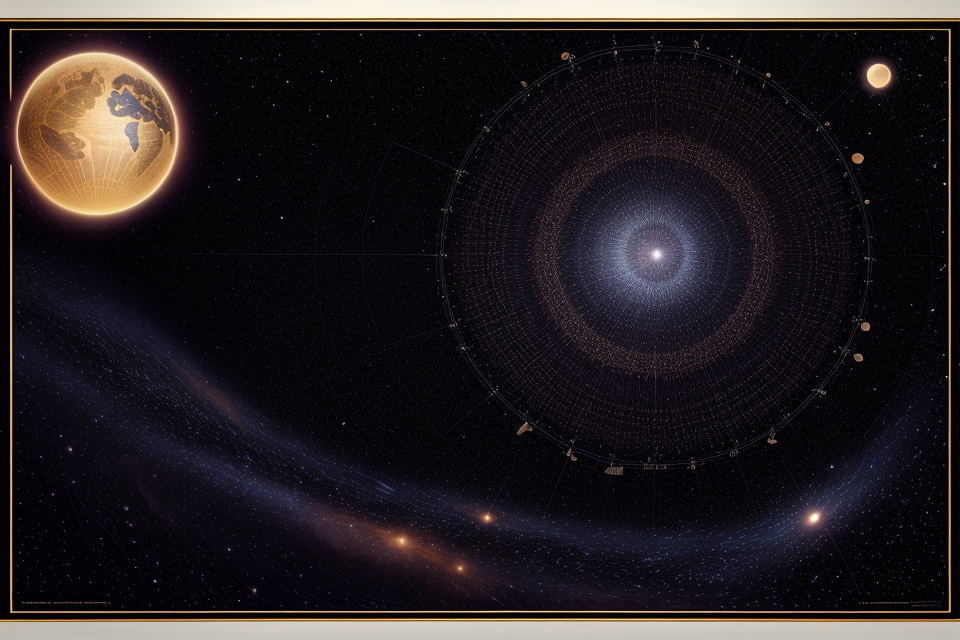Have you ever looked up at the night sky and marveled at the beautiful patterns of stars that make up the constellations? Have you ever wondered why there are only 88 constellations recognized by astronomers? The answer to this question lies in the history of astronomy and the way that humans have perceived the night sky throughout the ages. Join us as we delve into the mystery of the 88 constellations and explore the fascinating stories behind these celestial patterns. Get ready to be captivated by the beauty and wonder of the night sky!
The Celestial Sphere and the 88 Constellations
What is the Celestial Sphere?
- The Celestial Sphere is a spherical object that encompasses the Earth and all the celestial bodies in the sky. It is an imaginary sphere that is used to map the positions of stars, planets, and other celestial objects in the sky.
- The Celestial Sphere is an important concept in astronomy because it allows astronomers to study the movement of celestial objects relative to each other and to the Earth. By using the Celestial Sphere, astronomers can accurately predict the positions of celestial objects in the sky at any given time.
- The Celestial Sphere is also used to define the coordinates of celestial objects. These coordinates are measured in terms of their distance from the Earth and their angle relative to the Earth’s equator. This system of coordinates allows astronomers to precisely locate celestial objects in the sky and study their movements over time.
- The Celestial Sphere is an ancient concept that has been used by astronomers for thousands of years. It was first described by the ancient Greek astronomer Ptolemy in his book “Almagest,” which was written in the 2nd century AD. Since then, the Celestial Sphere has been an essential tool for astronomers, allowing them to study the movements of celestial objects and understand the nature of the universe.
The 88 Constellations
- Ancient origins and cultural significance
- Modern use in navigation and stargazing
Ancient Origins and Cultural Significance
The 88 constellations have been known to humans for thousands of years, with early civilizations developing their own myths and legends to explain the patterns in the night sky. These constellations were used not only for navigation but also for religious and cultural purposes. For example, the ancient Greeks believed that the constellations were created by the gods and represented stories from Greek mythology. The constellation Orion, for instance, was said to be a hunter who was placed in the sky by the gods after his death.
In other cultures, the constellations were associated with different stories and meanings. The Chinese, for example, divided the night sky into 28 constellations, each with its own name and mythological significance. The constellation Cassiopeia, which is visible in the northern hemisphere, was said to be a queen who boasted about her beauty and was placed in the sky as a punishment.
Modern Use in Navigation and Stargazing
Today, the 88 constellations continue to be used for navigation and stargazing. Navigationally, the constellations are used to help determine location and direction. The positions of the constellations in the sky change slowly over time, which allows sailors and other navigators to use them as a reference point to determine their location.
For stargazers, the constellations provide a way to identify different celestial objects and learn more about the universe. Each constellation is named after a particular shape or pattern of stars, which makes it easier for stargazers to identify them in the night sky. Many stargazers also enjoy learning about the myths and legends associated with each constellation, which adds to the mystery and allure of the night sky.
The Limits of the 88 Constellations
The Earth’s Rotation and the Apparent Movement of the Stars
The night sky, as we observe it, is not static. The stars appear to move in a cyclic pattern, a phenomenon caused by the Earth’s rotation. Our planet rotates on its axis once every 24 hours, which means that every point on the Earth’s surface revolves 360 degrees in this time. As a result, the stars appear to move from east to west, following the rotation of the Earth.
However, this apparent movement of the stars is not uniform, and there are variations that occur over long periods. One such variation is the “precession of the equinoxes,” a phenomenon that alters the position of the stars in the night sky over thousands of years. This precession is caused by the gravitational forces of the Sun and the Moon, which tilt the Earth’s axis by about 26 degrees. As a result, the position of the stars in the night sky shifts over time, making it difficult to define the exact boundaries of the 88 constellations.
Despite these limitations, the 88 constellations remain an important part of our understanding of the night sky and the movements of the stars. By studying the apparent movement of the stars and the effects of the Earth’s rotation, we can gain a deeper appreciation of the complex and dynamic nature of the universe.
The Ecliptic and the Zodiac
Definition and Explanation of the Ecliptic Plane
The ecliptic plane is an imaginary circle that is tilted at an angle of about 23.5 degrees relative to the celestial sphere. It is the path that the Sun, the Moon, and the planets appear to travel across the sky over the course of a year. This plane is important in astronomy because it is the reference frame for the positions of the celestial bodies, and it is the basis for the division of the sky into the twelve constellations of the zodiac.
The Twelve Constellations of the Zodiac and Their Significance
The twelve constellations of the zodiac are named after animals or objects that were believed to be associated with them in ancient times. These constellations are:
- Aries, the ram
- Taurus, the bull
- Gemini, the twins
- Cancer, the crab
- Leo, the lion
- Virgo, the maiden
- Libra, the scales
- Scorpio, the scorpion
- Sagittarius, the archer
- Capricornus, the goat
- Aquarius, the water-bearer
- Pisces, the fish
Each of these constellations is associated with a specific time of year, based on the position of the Sun relative to the ecliptic plane. The constellations are arranged in a belt across the sky, with each constellation covering a span of about 30 degrees in longitude. The zodiac is an important aspect of astrology, as the positions of the planets relative to the zodiac are believed to have an influence on human affairs.
The Evolution of Constellations
Historical Changes in Constellation Boundaries
The evolution of constellations is a fascinating topic that sheds light on the historical and cultural changes that have shaped our understanding of the night sky. One of the most significant aspects of this evolution is the changes in constellation boundaries.
- The role of cultural and religious beliefs in shaping constellations
Cultural and religious beliefs have played a crucial role in shaping the way we perceive the night sky and the constellations within it. Different cultures have developed their own unique systems of constellations, often based on their mythology and religious beliefs. For example, the ancient Egyptians saw the constellations as the gods and goddesses of their pantheon, while the Greeks associated their constellations with their own myths and legends.
- The influence of scientific discoveries on constellation boundaries
Scientific discoveries have also had a significant impact on the way we perceive the night sky and the constellations within it. As our understanding of the universe has expanded, we have discovered new celestial objects and phenomena that have required changes to the traditional constellation boundaries. For example, the discovery of galaxies beyond our own Milky Way has led to the creation of new constellations that reflect our expanded knowledge of the cosmos.
In addition to these factors, the evolution of constellation boundaries has also been influenced by changes in technology and astronomical instrumentation. The invention of the telescope, for example, allowed astronomers to observe the night sky in greater detail and led to the discovery of many new celestial objects and phenomena. This, in turn, has required changes to the traditional constellation boundaries to reflect our newfound knowledge of the universe.
Overall, the evolution of constellation boundaries is a complex and multifaceted process that reflects the interplay between cultural, religious, scientific, and technological factors. By understanding this evolution, we can gain a deeper appreciation of the rich history and culture of astronomy, and the ways in which our understanding of the universe has evolved over time.
Modern Constellations and their Limitations
- The International Astronomical Union (IAU) played a significant role in defining the modern constellations. In the late 1920s, the IAU established a committee to standardize the constellation boundaries, which were previously defined by various astronomers and cultures. The IAU’s goal was to create a uniform system for observing the night sky.
- However, the modern constellation system has faced criticisms for its limitations. One major limitation is that it does not take into account the movement of the Earth in its orbit around the Sun. As a result, the position of the constellations appears to shift over time, making it difficult to accurately locate celestial objects.
- Additionally, the modern constellation system is based on the equatorial coordinate system, which only works well for observers located near the Earth’s equator. For observers located at higher latitudes, the constellations appear distorted, and it becomes more challenging to identify celestial objects.
- Another limitation of the modern constellation system is that it does not account for the movement of the Milky Way galaxy. The Milky Way is a barred spiral galaxy, and its stars and gas are in constant motion. This motion causes the appearance of the constellations to change over time, making it difficult to accurately locate celestial objects.
- Furthermore, the modern constellation system is based on the idea of constellations as arbitrary shapes, which does not reflect the cultural and historical significance of constellations in different societies. Many cultures have their own stories and legends associated with the constellations, and the modern system does not capture these narratives.
- In summary, the modern constellation system has faced criticisms for its limitations, including its lack of accuracy, lack of consideration for the movement of the Earth and the Milky Way, and its lack of cultural significance. Despite these limitations, the modern constellation system remains widely used and recognized in astronomy today.
Alternative Views on the Night Sky
The Need for a Rethinking of Constellations
The traditional 88 constellations, which have been recognized and studied for centuries, have several limitations that suggest the need for a more accurate and inclusive system.
- Lack of accuracy: The boundaries of the traditional constellations are often arbitrary and do not accurately reflect the celestial bodies they represent. For example, the constellation Orion is based on the shape of a hunter, but the stars that make up the constellation do not actually form a recognizable image in the night sky.
- Limited cultural representation: The traditional constellations are based on Greek and Roman mythology, and do not include many cultures or regions of the world. This lack of diversity in the constellations limits the ability of people from different cultures to connect with the night sky.
- Inconsistent naming conventions: The names of the traditional constellations are often confusing and inconsistent, with some constellations having multiple names and some stars having multiple constellations associated with them. This can make it difficult for people to understand and navigate the night sky.
Therefore, a more accurate and inclusive system of constellations is needed to better reflect the beauty and diversity of the night sky and to allow people from all cultures to connect with it.
Alternative Systems of Celestial Navigation
When it comes to understanding the night sky, it’s important to consider the various systems of celestial navigation that have been developed throughout history. Different cultures have used different methods to track the movements of the stars and planets, and many of these alternative systems offer unique insights into the mysteries of the universe.
Examples of alternative systems used in different cultures
One example of an alternative system of celestial navigation is the Hindu system of astronomy, which is based on the concept of the “yuga.” According to this system, the universe goes through cycles of creation and destruction, and the positions of the stars and planets are believed to have a direct impact on human life. Another example is the ancient Chinese system of astronomy, which was based on the observation of the “moving heavens” and the use of a complex system of calendars and astrological charts.
The potential benefits of using alternative systems
While the Western system of celestial navigation based on the Gregorian calendar and the tropical zodiac is widely used today, there are benefits to exploring alternative systems of celestial navigation. For one, these systems often offer a unique perspective on the night sky and can help us understand the movements of the stars and planets in new ways. Additionally, by studying these alternative systems, we can gain a better appreciation for the diversity of human knowledge and experience, and the ways in which different cultures have sought to understand the mysteries of the universe.
FAQs
1. What are constellations?
Constellations are areas of the night sky that are named after shapes that we can see in the stars. They have been recognized by humans for thousands of years and have been used for navigation, cultural and religious purposes.
2. Why are there only 88 constellations?
The number 88 is the result of a convention set by the International Astronomical Union (IAU) in 1922. Prior to this, there were many different lists of constellations used by different cultures, and some of these lists included more than 88 constellations. The IAU established a standard list of 88 constellations, which is still used today.
3. What are the 88 constellations?
The 88 constellations are: Andromeda, Apus, Aquarius, Aquila, Ara, Aratus, Aries, Auriga, Cancer, Canis Major, Canis Minor, Capricornus, Carina, Cassiopeia, Cepheus, Cetus, Cygnus, Delphinus, Dorado, Eridanus, Cetus, Fornax, Gemini, Grus, Hercules, Hydra, Indus, Jao, Leo, Leo Minor, Lepus, Libra, Lupus, Lyra, Microscopium, Monoceros, Norma, Orion, Perseus, Phoenix, Pisces, Pisces Austrinus, Pyxis, Scorpius, Sculptor, Serpens, Serpens Caput, Sextans, Taurus, Telescopium, Triangulum, Triangulum Australe, and Vulpecula.
4. How were the constellations named?
The constellations were named by ancient civilizations, who used their imaginations to see familiar shapes in the stars. Many of the constellations were named after mythological figures or creatures from Greek and Roman mythology. The names have been passed down through the centuries and are still used today.
5. Are there any constellations that are not named after mythological figures?
Yes, there are a few constellations that are not named after mythological figures. For example, Monoceros is named after a unicorn, which is a mythical creature, but the constellation is not specifically associated with any particular myth or legend. Some constellations, such as Cetus, are named after sea monsters, which were also popular in ancient mythology.



